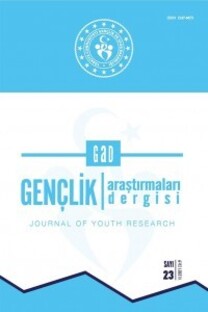Hemşirelik Öğrencilerinde Ortoreksiya Nervosa (ON) ve Beden İmajı İle İlişkisi
Orthorexia Nervosa, Sosyal Görünüş Kaygısı, Hemşirelik Öğrencisi
The Relationships Between Orthorexia Nervosa And Body Image In Nursing Students
Orthorexia Nervosa, Body Image, Nursing Students,
___
- Aktürk, Ü., Gül, E., Erci, B. (2019). The effect of Orthorexia Nervosa levels of nursing students and diet behaviors and socio-demographic characteristics. Ecology of Food and Nutrition.
- Arslantaş, H., Adana, F., Öğüt, S., Ayakdaş, D., Korkmaz, A. (2017). Hemşirelik öğrencilerinin yeme davranışları ve ortoreksiya nevroza (sağlıklı beslenme takıntısı) ilişkisi: Kesitsel bir çalışma. Psikiyatri Hemşireliği Dergisi, 8(3), 137–144.
- Arusoğlu, G. (2006). The investigation of healthy eating fixation (Orthorexia) and the adaptation of the ORTO-15 scale. Dissertation, Hacettepe University, Institute of Health Sciences, Ankara, Turkey. (in Turkish).
- Arusoğlu, G., Kabakci, E., Köksal, G., Merdol, T.K. (2018). Orthorexia Nervosa and adaption of ORTO-11 into Turkish. Turkish Journal of Psychiatry, 19(3), 283-292. . (in Turkish).
- Barnes, M.A., Caltabiano, M.L. (2017). The interrelationship between orthorexia nervosa, perfectionism, body image andattachment style. Eating and Weight Disorders, 22, 177–184.
- Bóna, E., Szél, Z., Kiss, D., Gyarmathy, V.A. (2019). An unhealthy health behavior: analysis of orthorexic tendencies among Hungarian gym attendees. Eating Weight Disorders, 24, 13–20.
- Brytek-Matera, A., Donini, L.M., Krupa, M., Poggiogalle, E., Hay, P. (2016). Errartum to: Orthorexia nervosa and self-attitudinal aspects of body image in female and male university students. Journal of Eating Disorders, 3, 2-8.
- Brytek-Matera, A., Fonte, M.L., Poggiogalle, E., Donini, L.M., Cena, H. (2017). Orthorexia nervosa: relationship with obsessive-compulsive symptoms, disordered eating patterns and body uneasiness among Italian university students. Eating and Weight Disorders, 22(4), 609-617.
- Brytek-Matera, A., Gramaglia, C., Gambaro, E., Delicato, C., Zeppegno, P. (2018). The psychopathology of body image in orthorexia nervosa. Journal of Psychopathology, 24, 133-140.
- Bundros, J., Clifford, D., Silliman, K., Neymas Morris, M. (2016). Prevalence of Orthorexia nervosa among college students based on Bratman's test and associated tendencies. Appetite, 1, 101:86-94. doi: 10.1016/j.appet.2016.02.144.
- Cash, T.F. (2015). Multidimensional Body–Self-Relations Questionnaire (MBSRQ). Encyclopedia of Feeding and Eating Disorders, doi: 10.1007/978-981-287-087-2_3-1
- Chaki, B., Pal, S., Bandyopadhyay, A. (2013) Exploring scientific legitimacy of orthorexia nervosa: A newly emerging eating disorder. Journal of Human Sport and Exercise, 8, 1045-1053.
- Çiçekoğlu, P., Tunçay, G.Y. (2018). A Comparison of eating attitudes between vegans/vegetarians and nonvegans/nonvegetarians in terms of orthorexia nervosa. Archieves of Psychiatric Nursing, 32, 200–205. https://doi.org/10.1016/j.apnu.2017.11.002
- Çulhacık, G.D., Durat, G. (2017). Ortorektik eğilimlerin yeme tutumu ve obsesif kompulsif belirtilerle ilişkisi. Journal of Human Sciences, 14(4), 3571-3579. doi:10.14687/jhs.v14i4.4729 2017.
- Doğan, O., Doğan, S. (1992). Çok Yönlü Beden Self İlişkileri Ölçeği El Kitabı. Cumuriyet University Publication Number: 53. Sivas, Turkey. (in Turkish).
- Duran, S. (2016). The risk of orthorexia nervosa (healthy eating obsession) symptoms for health high school students and affecting factors. Pamukkale Medical Journal, 9(3), 220-226. doi: 10.5505/ptd.2016.03880. (in Turkish).
- Ergin, G. (2014). Sağlık personeli olan ve olmayan bireylerde ortoreksiya nervosa sıklığı araştırması. Dissertation, Başkent University, Institute of Health Sciences, Ankara, Turkey. (in Turkish).
- Figueiredo, R.A.O., Simola-Ström, S., Isomaa, R., Weiderpass, E. (2019). Body dissatisfaction and disordered eating symptoms in Finnish preadolescents. Eating Disorders, 27(1), 34-51. doi: 10.1080/10640266.2018.
- Grammatikopoulou, M.G., Gkiouras, K., Markaki, A., Theodoridis, X., Tsakiri, V., Mavridis, P., Dardavessis, T., Chourdakis, M. (2018). Food addiction, orthorexia, and food-related stress among dietetics students. Eating and Weight Disorders- Studies on Anorexia, Bulimia and Obesity, doi: 10.1007/s40519-018-0514-1
- Koven, N.S., Abry, A.S. (2015). The clinical basis of orthorexia nervosa: emerging perspectives. Neuropsychiatric Disease and Treatment, 11, 385-394. doi: 10.2147/NDT.S61665
- Plichta, M., Jezewska-Zychowicz, M., G˛ebski, J. (2019). Orthorexic tendency in polish students: exploring association with dietary patterns, body satisfaction and weight. Nutrients Appetite, 11: 2-19. doi:10.3390/nu11010100
- Roncero, M., Barrada, J.R., Perpiñá, J. (2017). Measuring Orthorexia Nervosa: Psychometric Limitations of the ORTO-15. The Spanish Journal of Psychology, 20, 20: E41. doi: 10.1017/sjp.2017.36.
- Scarff, J.R. (2017). Orthorexia Nervosa: An obsession with healthy eating. Federal Practitioner, 34(6), 36-39.
- Segura-Garcia, C., Ramacciotti, C., Rania, M. et al. (2015). The prevalence of orthorexia nervosa among eating disorder patients after treatment. Eat Weight Disord, doi: 10.1007/s40519-014-0171-y
- Tremelling, K., Sandon, L, Vega, G.L., McAdams, C.J. (2017). Orthorexia nervosa and eating disorder symptoms in registered dietitian nutritionists in the United States. Journal of Academy of Nutrition and Dietetics, 117(10), 1612-1617.
- Yeşil, E., Turhan, B., Tatan, D., Şarahman, C., Saka, M. (2018). Yetişkin bireylerde cinsiyetin ortoreksiya nervosa eğilimine etkisi. Ankara Sağlık Bilimleri Dergisi, 7, (1), 1-9. (in Turkish).
- Varga, M., Thege, B.K., Dukay-Szabó, S., Túry, F., van Furth, E.F. (2014). When eating healthy is not healthy: Orthorexia nervosa and its measurement with the ORTO-15 in Hungary. BMC Psychiatry, 59, 2-11. doi: 10.1186/1471-244X-14-59.
- ISSN: 2147-8473
- Yayın Aralığı: 3
- Başlangıç: 2012
- Yayıncı: T.C. Gençlik ve Spor Bakanlığı Eğitim, Kültür ve Araştırma genel Müdürlüğü
Ergenlerde Siber Zorbalığın İnsani Değerler Açısından İncelenmesi
Gaye KURT KABAN, Mücahit GÜLTEKİN
Hemşirelik Öğrencilerinde Ortoreksiya Nervosa (ON) ve Beden İmajı İle İlişkisi
Günümüz Gençliğini ve Sorunlarını Gençlerin Kaleminden Süzülen Hikâyelerden Anlamak
Şeyma RODOP, Sümeyye YILDIRIM, Pelin DİKMEN YİLDİZ, Aslı GÜRTUNCA HANİF
Abdullah USLU, Filiz KARAKOYUNLU
Gençlerin Teknoloji Kabulünün ve Web Sitesi Tasarımının Online Alışveriş Deneyimi Üzerindeki Etkisi
